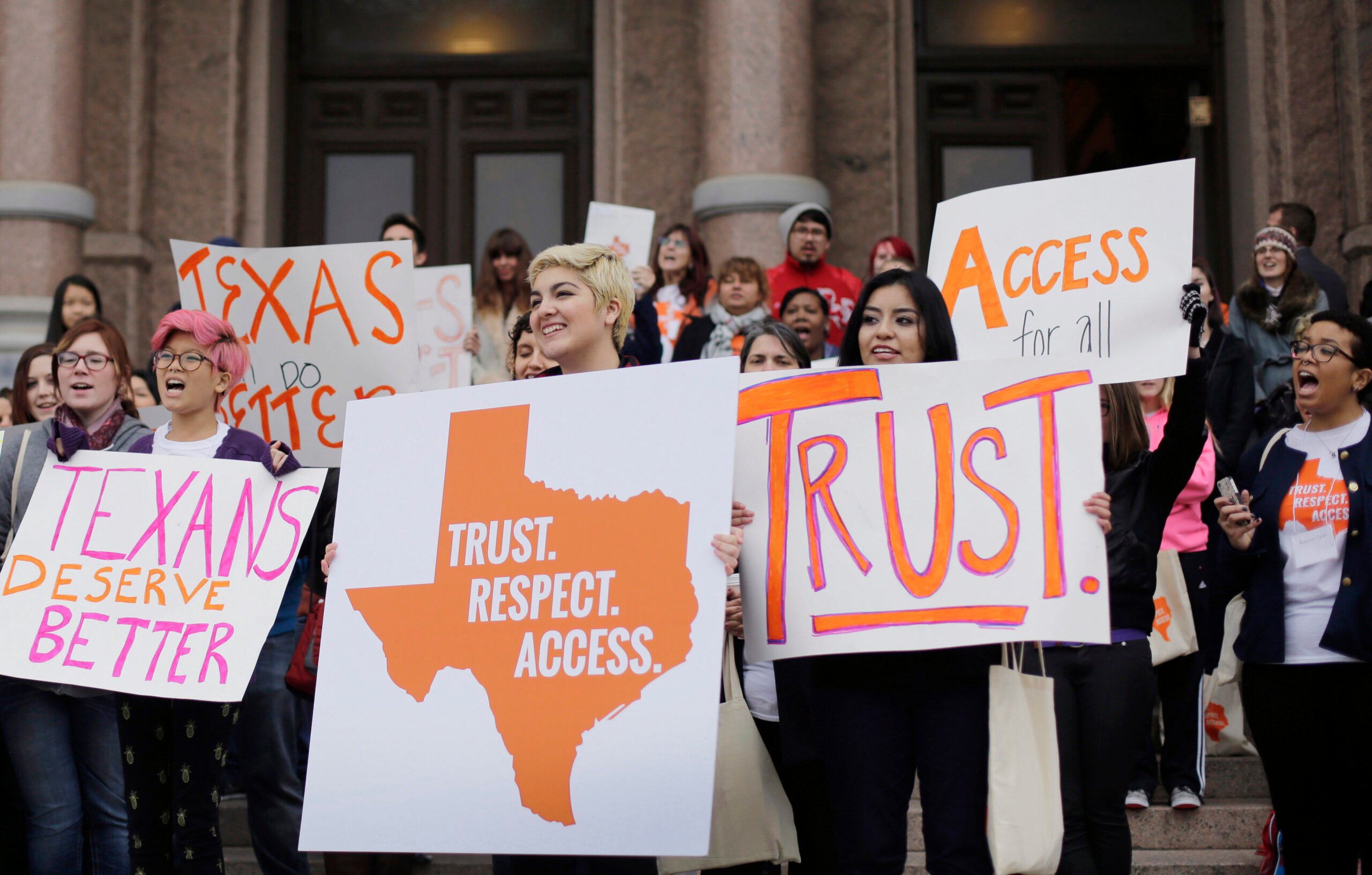One Year Later, Cuts to Women’s Health Have Hurt More Than Just Planned Parenthood
More than 60 family planning clinics forced to close—only 12 belonged to Planned Parenthood. Critics say conservative lawmakers are ‘throwing the baby out with the bath water.’
The first in an occasional series of stories examining the impact of deep cuts to family planning services in Texas.

Diaphragms. Depo-Provera injections. Oral contraceptives. Pregnancy testing. Pap smears. Screening for sexually transmitted diseases. Since July 1, basic services like these are no longer accessible to low-income women in rural San Saba County, two hours northwest of Austin. If a poor woman in San Saba hopes to prevent pregnancy, she now must pay a private doctor or drive an hour to a free clinic. But for the many poor women, teens and undocumented clients of San Saba’s family planning program—run by Hill Country Community Action—both payment and travel may be beyond reach. The large majority of the program’s clients couldn’t afford contraceptives; of the 2,500 visits to the program in the last nine months, only 28 clients paid full fee, according to program records. Now that Hill Country Community Action has lost state family planning funds, San Saba County’s ability to prevent unwanted pregnancies just became a great deal harder.
What happened in San Saba County is being repeated all over Texas. In the year since deep cuts to family planning funding took effect, the impact has become apparent. An Observer review of state records has found that 146 clinics have lost state funds, clumped mainly in the Panhandle, Central Texas and on the border with Mexico. More than 60 of those clinics have closed their doors forever. The number of organizations that help poor women plan pregnancy has shrunk by almost half. As in San Saba, low-income women in many areas of Texas now face a long drive, or worse, lack of access to birth control and health screenings.
This isn’t news to conservative state lawmakers. After all, in its 2011 session, the Texas Legislature cut the state’s family planning program by two-thirds. Public health experts warned lawmakers at the time that by defunding Texas’s family planning system, clinics would close and a spike in disease, pregnancies and abortions would follow. Regardless, they slashed the budget. Lawmakers were quite clear about their motivation: They hoped to drive abortion providers out of business. Their specific target—Planned Parenthood—also provides family planning and preventive health care to low income women. In their zeal to attack Planned Parenthood, politicians designed a funding formula that caused collateral damage. They defunded many other family planning clinics that aren’t connected to Planned Parenthood and don’t offer any abortion services.
In fact, of the more than 60 clinics that have closed across Texas, only 12 were run by Planned Parenthood. Dozens of other clinics unconnected to Planned Parenthood nonetheless lost state funds and have closed, leaving low-income women in large areas of the state without access to contraception.
It gets worse. The federally qualified health centers—which lawmakers said could provide family planning services to low-income women and make up for the cuts—have themselves experienced a funding crunch and are struggling to absorb demand. The result is that costs have shifted to patients, and exceptionally poor women now make hard choices about paying for their well-woman care. Some will find the cash, but an alarming number won’t. Indeed, the bipartisan Legislative Budget Board estimated that last year’s cuts would lead to more than 250,000 women losing services and 20,000 additional births covered by Medicaid. When The Texas Observer asked providers what they thought about the cuts, several mentioned the same phrase. They said in hoping to punish Planned Parenthood, politicians had gone too far, with devastating consequences for women’s health. Lawmakers, they said, had thrown the “baby out with the bath water.” In this story, the first in an occasional series, we examine what happened to the family planning providers who have fallen from favor.
Clinic Closures
The reduced family planning budget has destabilized every provider in Texas, whether they were small, rural organizations or large community programs in metropolitan areas. They all depend on public funding, and the large cut to their budgets forced them to reduce services, fire staff and, in some cases, close shop completely. Many of the providers that haven’t closed teeter precariously on funds from another endangered source—the Women’s Health Program. This Medicaid-funded program pays for many of the same services as the state family planning program that lawmakers cut last session. The Women’s Health Program’s future in Texas is in doubt as well. A federal court is expected to decide this fall if Texas can legally exclude Planned Parenthood from the Women’s Health Program. That ruling could determine if clinics continue to receive WHP funds or if Texas can scuttle the program entirely. Texas officials have said they will end the program rather than include Planned Parenthood. If the Women’s Health Program in Texas does end, more clinics may close.
But many providers already have been driven out of business. The Department of State Health Services says it doesn’t track clinic closures, though they do “receive anecdotal accounts from contractors,” according to an agency spokesperson. Fran Hagerty, executive director of the Women’s Health and Family Planning Association of Texas, recently surveyed its members and found that nearly 50 of her members’ clinics have closed. “Some entire organizations have shut down,” she said, “and even those that did get funding didn’t get enough to stay open. Even those programs that are still functioning … just about all of them have shut some clinics.” Hagerty’s organization is itself feeling effects from the cutbacks. With its members’ clinics closing, Hagerty’s group has been destabilized.
Most Closures in Poor, Rural Areas
The defunct providers cluster primarily in remote areas, where communities are too poor to share costs with clinics. Hill Country Community Action, for example, based in San Saba and serving low income women across 10 rural counties, had nowhere else to turn. When asked why Hill Country Community Action lost funding, the Department of State Health Services spokesperson wrote in a emailed statement: “This agency is a Tier 3 agency. No Tier 3 agency was funded as a result of legislative guidance.” This is a reference to the state’s brand-new tiered funding system. At the Legislature’s direction, the Department of State Health Services created the tiered system to ensure that state money went primarily to Federally Qualified Health Centers, which were designated Tier 1, which got the most funding. Tier 3 includes Planned Parenthood facilities and other clinics the state had deprioritized for funding. Because Hill Country fell into the same technical category as Planned Parenthood, safety net health services for more than 2,000 women in central Texas vanished.
South Plains Community Action suffered the same fate. Family planning clinics in Levelland, Lubbock, Plainview, Spur and Whiteface closed down, robbing services from 3,800 low-income women. Ex-patients must now make a 100 mile round-trip to the nearest facility. But as Executive Director William Powell laments, “We have no idea what happened to those women.”
Bell County Public Health District also stopped providing family planning services. The health district had been designated as the highest-priority provider, but still saw a drop in funding. The reduced state budget wasn’t enough to keep it afloat, said Bonnie Scurzi, the district’s director. Now Bell County provides only STD and pregnancy tests, referring 3,000 women elsewhere for birth control and well-women care. Scurzi noted that many of her patients are so poor that they came to her clinic in their house slippers. Now, she reluctantly sends them to Planned Parenthood in Waco, where they must pay full fee, or to the federally qualified health center in Temple, which tells callers that it isn’t accepting new patients.
Planned Parenthood has also been hit hard. Since being excluded from state funds for family planning, Planned Parenthood has closed 12 health centers, removing health exams and birth control from 20,500 women. Areas that have lost a Planned Parenthood include large metro areas such as Arlington, Mesquite, Plano, Odessa and Brownsville. Other cities where Planned Parenthood closed clinics include Mission, Rio Grande City, Alice and Terrell. Now, women in these areas must travel further or forgo care altogether.
Still Open, But Barely
Some providers haven’t closed down completely but were forced to limit their geographical range. Community Action Inc. of Central Texas lost all state funding, for example, causing family planning clinics in Round Rock and Elgin to close. Now the remaining two clinics in Lockhart and San Marcos are in a precarious financial situation because they rely almost entirely on funds from the Women’s Health Program.
Even providers who survived the carnage are still forced to share costs with patients. El Buen Samaritano Episcopal Mission, which had lost all state funds, was bailed out by Austin’s donor community. Though El Buen is still in the family planning business, women see a difference. El Buen can no longer afford to offer the NuvaRing, a contraceptive vaginal ring, which costs $90 a month. Intrauterine (IUD) devices were once free. Now, women must apply for external funding, and if they aren’t eligible, they can’t have the IUD either. In addition, El Buen no longer offers the long-acting birth control method, Implanon. Though the clinic still provides condoms, oral contraception and the Depo-Provera injection, costs have crept in. The injection now costs women $40 for three months and the pill requires a co-pay. Executive Director Victor Azios says he feels fortunate that El Buen wasn’t as affected as other providers, but is exasperated by what happened to the family planning infrastructure. “Politicians didn’t take account of how the system works,” he said. “Where do they think these women will go?”
Who Absorbs the Demand?
According to lawmakers’ grand plan, patients who no longer had access to family planning clinics would go to federally qualified health centers. Indeed, the vast majority of organizations receiving state funds are large community health centers aimed at serving the poorest of the poor, according to state records. Yet in this stripped-down budget cycle, these federally qualified health centers received only a fraction of the money they need.
The result is that federally qualified health centers are having treat more patients, but have less money to do it.
Lone Star Circle of Care, which must absorb many of Hill Country’s and Community Action’s displaced clients in Central Texas, got only a third of what its family planning program costs. Now, explains communications director Rebekah Haynes, the number of state-funded family planning spots are vastly reduced, so if women aren’t covered by insurance, then they will be asked to pay fees on a sliding scale. Lone Star makes up the shortfall by cross-subsidizing from its other funds. Haynes says that the health center hasn’t yet seen a significant spike in patients from outlying areas.
However, Legacy Community Healthcare in Houston, another federally qualified health center that received reduced state funds, has seen an uptick. Randall Ellis, director of government relations for Legacy, notes that since last June, the health center has seen an almost 49 percent increase in clients seeking family planning services, some of whom are new patients who can’t be seen by their previous providers. Anecdotally, officials with several federally qualified health centers interviewed for this story said they are seeing a slow increase in new patients seeking family planning care after closure of a clinic.
“They aren’t all going to hit our doors at once,” said Michael Austin, CEO of Midland Community Healthcare, the federally qualified health center that is receiving displaced patients from Planned Parenthood’s closed clinic in Odessa. “But as each interval clicks by, we’ll see more. The momentum is building.”
What Does this Mean for Women?
Under this new bare-bones regime, women are expected to go to federally qualified health centers, whether they are geographically accessible or not. Those health centers, battling to see more patients on less money, will be forced to underwrite their care with Women’s Health Program funds, other state and federal pots, and from private donations. Providers will also shift costs to patients. This gloomy scenario might work if three assumptions about poor women are true: that they are mobile, that they qualify for services under the Women’s Health Program (if it’s still around) and they can afford to share the cost of contraception.
Yet serious problems in the model are emerging. Lawmakers’ preferred providers—federally qualified health centers—are reeling and one, meant to anchor Bell County, has already collapsed. The state reports a threefold reduction in family planning claims from last year but it’s not clear where that unmet demand has gone. As each month passes, a growing number clinics that had stitched a complex system together are closing their doors forever.
In hoping to punish Planned Parenthood, politicians handicapped other providers and in so doing, left a safety net for 220,000 women in tatters. By politicizing women’s health, state lawmakers are risking a public health crisis.
Carolyn Jones is a freelance writer in Austin. You can find more of her work at www.carolynjoneswrites.com .


